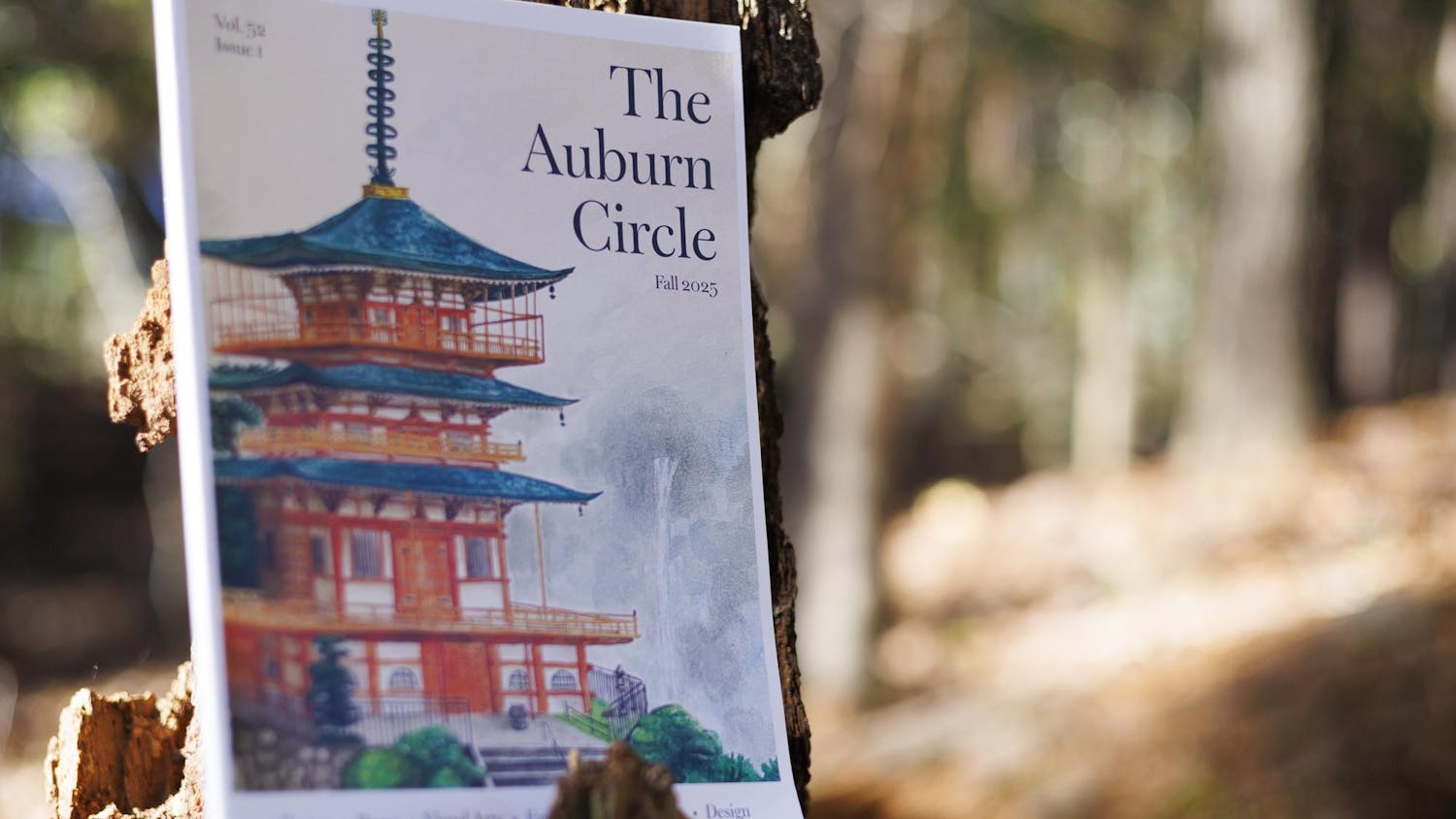Late Saturday afternoon in Ocean Springs, Miss., a few children splashed in the warm gulf surf as their parents watched from the shore, while over a section of deflated, orange containment boom strewn across riprap, a great blue heron took flight.
A handful of gloppy, black dollops or wafers blotted the beach, but those types of weathered tar balls are relatively safe because all of the volatiles have been blown off or broken down, according to Dr. LaDon Swann, associate research professor at Auburn University and director of the Mississippi-Alabama Sea Grant Consortium and the Auburn University Marine Extension and Research Center (AUMERC).
Swann is one of the numerous Auburn University researchers responding to the catastrophic oil spill menacing the livelihoods of Gulf Coast residents and the marshes, beaches, reefs and marine wildlife composing Alabama's coastal habitats.
As director of AUMERC, Swann, who is stationed in the Mobile area, works closely with the Auburn University Shellfish Laboratory on Dauphin Island. Last week, significant "patches of gooey masses" or "mousse sorts of things" began washing ashore along the island's white-sand beaches, he said. BP's 2009 Regional Oil Response Plan describes the mousse as a "water-in-oil emulsion which is often orange to rust colored. It is thick and viscous and may contain 30% oil."
Dr. Prabhakar Clement, an Auburn University professor who holds the Arthur H. Feagin Chair of Civil Engineering and specializes in hydraulics and hydrology, said he suspects BP's application of the dispersant Corexit at the gushing vent of crude may account for the plumes of mixed oil and dispersant spread throughout the water column over a large volume of water.
"When they actually add dispersants, the oil gets emulsified," he said, "and basically, a substantial portion of the oil might not be floating on water. It's perhaps dispersed throughout the water column as tiny blobs."
"With a large amount of dispersant," added Clement, "there is the potential that a large mass is trapped as dispersed bubbles in the water column which may not come up, at least close to the disaster zone. This could be happening at the (Deep Water Horizon) site. That is perhaps the reason why NOAA's estimate of the oil spill based on surface observation was low because the bulk of the oil is perhaps still trapped in the water column."
Clement said one of his primary interests as a hydraulics and hydrology professor is observing what happens during mixing (of oil and dispersant) to determine what fraction of these oils get emulsified and distributed in the water column. He said one of his colleagues has obtained a sample of crude and hopes to get a sample of the dispersant soon.
"I actually tried to get some Corexit from the manufacturer, Nalco," he said, "and I've been talking to the industry, but we still don't have a sample. I'm hoping that, at some time, they will give us a sample, or hopefully, we'll be able to buy some or get some from a different company, and do some of these experiments."
Clement said there are both positive and negative aspects to the use of dispersants, but he did not know whether using it was a good or bad idea. He said one positive effect of dispersants spreading oil over a larger area or volume and into smaller drops is that microbes can attack and eat small blobs better than a layer of oil. But spreading the mixture of oil and dispersant over a large volume is also a negative aspect, as is its unknown, long-term effects on marine species distributed over the deep column of water, he added.
"This has never been done before," he said, "we are experimenting with nature at a large scale, (which is) never a good thing."
One major concern is that these patches of mousse will settle under and possibly kill the subtidal oyster reefs as well as contaminate the sponge-like sargassum, which provides a habitat for many marine animals, such as the crabs now spawning offshore, Swann said.
"If they're in that sargassum," he said, "it's not looking good for them," adding that many leading scientists say a whole cohort, or year-class, of marine animals may be lost or experience a dramatic decline because of acute toxicity.
"Now, if they stop the leak, and they start cleaning up and continue to clean up," Swann said, "those animals that survive will spawn next year. But what you're going to see is a gap probably, or certainly, a significant decline in this year-class of a lot of different animals, fish and invertebrates."
He said officials are considering plugging the mile-wide Katrina Cut, a breach on the uninhabited west end of Dauphin Island formed when Hurricane Katrina swept through the area in 2005, in order to prevent oil from entering into the Mississippi Sound and contaminating marshes.
"They talked about sheet metal tiling," he added. "They talked about vinyl pilings. They talked about riprap. They talked about just putting sand in there."
"We're seeing things now that few people have ever seen. I'm not sure if anybody's ever seen," said Swann. "You know, desperate times call for desperate measures, and I think you're seeing all that come to bear now."
Early Saturday afternoon, among the pilings below the Shellfish Laboratory, Scott Rikard, the on-site facility manager and manager of Auburn University's Ag and Natural Resources Programs, was draining a large blue tank, which he said would be cleaned, refilled with fresh saltwater and then replenished with the roughly 3 million oyster larvae sitting in buckets on the floor. He explained two methods the lab uses to culture juvenile larvae into oysters ready to be planted on reefs.
In one method, larvae attach to grains of finely ground oyster shell, yielding hundreds of thousands of single oysters great for aquaculture and experimental work, he said. In the other method, larvae are set on full-sized oyster shells.
"We want them to grow into clusters, grow up into clumps," Rikard said. "And then we put these bags out, let them grow for a little while. Then we go back, cut the bags open and spread the shell out."
The oysters bred using this method are destined for a restoration project called the Mobile Bay Oyster Gardening Program. The lab gives volunteers a bag of oyster spat that they then keep clean and free of predators until the oysters are about two inches long, which takes roughly six months. At that point, the gardeners give them back, and the lab restores them to reefs, Rikard said.
"We're just so focused on this, trying to get these oysters through, but everything we're doing is trying to avoid the oil," he said. "It's very frustrating. You've got a company that can hit a spot 5,000 feet below the water's surface to drill, and yet they can't go down there and turn the thing off. It's so frustrating."
Instead of a site-specific response plan, BP submitted a Regional Oil Response Plan for the Gulf of Mexico in a 2009 application filed with the scandal-plagued Minerals Management Service. BP's worst-case scenario for an exploratory well more than 10 miles off the Gulf Coast was based on its Mississippi Canyon 462 lease, with an expected "worst case discharge" of "250,000 barrels of crude oil per day." Oddly, BP's regional response plan also included "walruses, sea otters and seals" as marine mammals "considered the most sensitive to oil spills" under a section identifying "sensitive biological and human-use resources."
Swann recalled the first meeting he went to after the rig exploded, which he said was attended by Sen. Richard Shelby, the U.S. Coast Guard, the Alabama Department of Environmental Management (ADEM) and BP.
"They acknowledged that day that the plan they had in place, response plan, wasn't designed for what we're seeing now," he said. "So I think everyone's overwhelmed, but they're doing the best they can with that situation." He added that the two agencies leading Alabama's response, the Alabama Department of Conservation and Natural Resources and the head agency ADEM, are doing a great job.
There are weekly meetings between Sea Grant and all of the Extension programs in the Gulf, including the Alabama Cooperative Education System (ACES) and Alabama's Extension Disaster Education Network (EDEN), he said. Virginia Morgan, an Extension administrator and the Alabama point-of-contact to EDEN for ACES, said ACES is collaborating with Extension systems in Texas, Louisiana, Mississippi and Florida to coordinate a response. She added that Extension directors and specialists, and other researchers are forming three multi-state task forces to respond to the oil spill.
"There's the food safety task force," said Morgan, "the damage assessment and disaster assistance task force, and there's another group that's focusing on family, community and financial issues."
Education is the primary focus of the nation-wide Extension system, which provides information that supports people who are going through tough times. Extension is helping communities, not necessarily organize, but get the education they need to respond to the oil spill, she said.
"You see a lot of frustration among citizens down here," said Swann. "You hear this, you hear that, but there's really no unified command from the standpoint of communication to the lowest levels. It needs to get down to everyone, needs to get down to people living in Heron Bay as well as people who live in mid-town Mobile."
He said the combination of effects from hurricanes, the recession and now the oil spill are a perfect storm that will cause an economic disaster for Alabama's working waterfronts and the allied industries supporting it, including restaurants and insurance companies.
"What terrifies me most is the economic and social side of this," said Swann. "Now, when people lose their livelihoods and it's going to be five years before they can get it back, what are they going to do? You know, I don't mean to ask a rhetorical question, but they're going to have to do something else, so it worries not just me, it worries us all that our working waterfronts may disappear."
"There are names down here that you associate since the 1600s when Dauphin Island settled," he added. "They've been fishing for that long. It's their heritage, and it's their livelihoods, and that's at stake. That worries everyone."
He stressed how important outreach organizations, such as ACES, EDEN and Sea Grant, are to Auburn University, as a land-grant university, the Gulf Coast community and especially Alabama's working waterfronts.
Swann said the state is working hard to ensure that the Vessel of Opportunity program only employs commercial and recreational fishermen from Alabama.
"The working waterfront people," he said, "are the ones that deserve to be employed, to be out there on standby to monitor for oil, to deploy boom, those sorts of things."
He added that Sea Grant, ACES and the Natural Resources Conservation Service recently organized a HazMat training course for 33 people that qualifies them to train others to work for a BP contractor cleaning up tar balls that wash ashore.
"We call it the tar-ball training," he said.
Clement said he drove to Dauphin Island four or five weeks ago and met with Swann, and they collected soil and sediment samples that will provide a baseline to compare against. While working on his PhD., Clement said he looked at some of the bioremediation related issues for oil spill management from a beach hydraulics point of view as part of an effort to manage the Exxon Valdez spill.
Instead of losing a lot of sand and reorganizing the beach by removing and disposing the contaminated sand column after oil washes ashore, nutrients like nitrate and phosphate can be introduced to promote bacterial growth along the beach, which will oxidize or mineralize the hydrocarbons, he said, adding that from a beach-cleanup point of view, bioremediation is an attractive option.
"We do intend to grow some microbes," he said, "and potentially attempt to re-mediate some of these oil-contaminated beaches using bioremediation techniques. It's about attacking or removing the crude oil using natural microbes. Now, the crude might be mixed with the dispersant, so we have to handle both during the actual work."
Behind the Shellfish Lab, two contract workers wearing rubber boots and gloves casually walked beside a long row of hay bales winding along the shoreline, occasionally stooping over and snatching a tar ball to toss in a bag. Nearby, stacks of tarp-covered bales and bags of loose hay sat in a staging area behind a chain-link fence.
Farther down the shore, facing the south side of Dauphin Island's public beach, people sunbathed and fed cheese puffs to hovering seagulls, though no one swam, while a cadre of contract workers in yellow vests or green industrial carts patrolled the Gulf surf. On the north side, between cart tracks and the edge of the Mississippi Sound's calm and shallow waters, a great blue heron stood, facing away from the faint outline of a rig on the horizon.
Do you like this story? The Plainsman doesn't accept money from tuition or student fees, and we don't charge a subscription fee. But you can donate to support The Plainsman.




